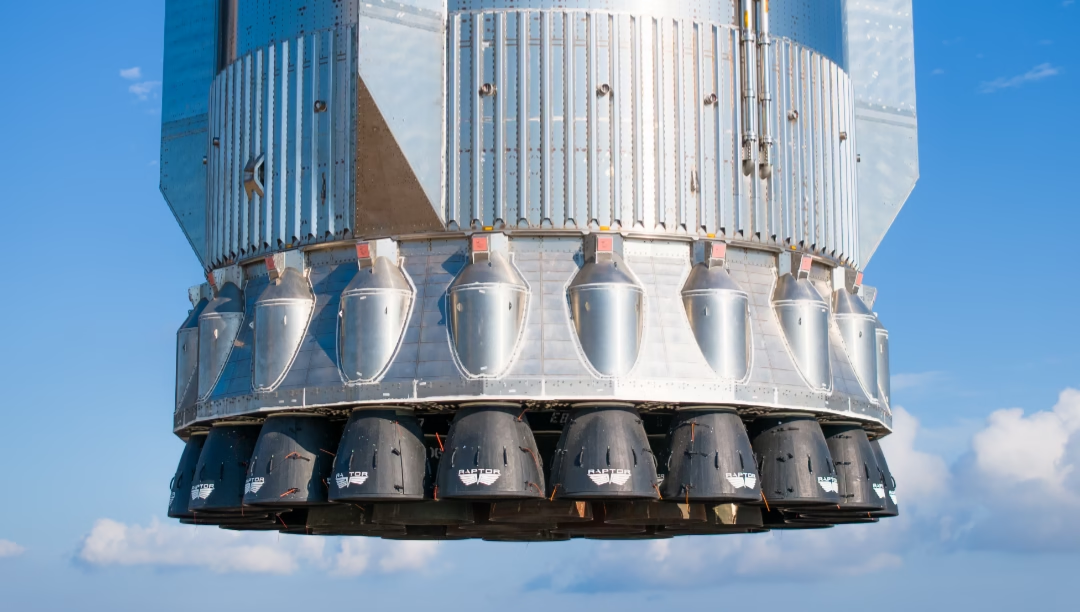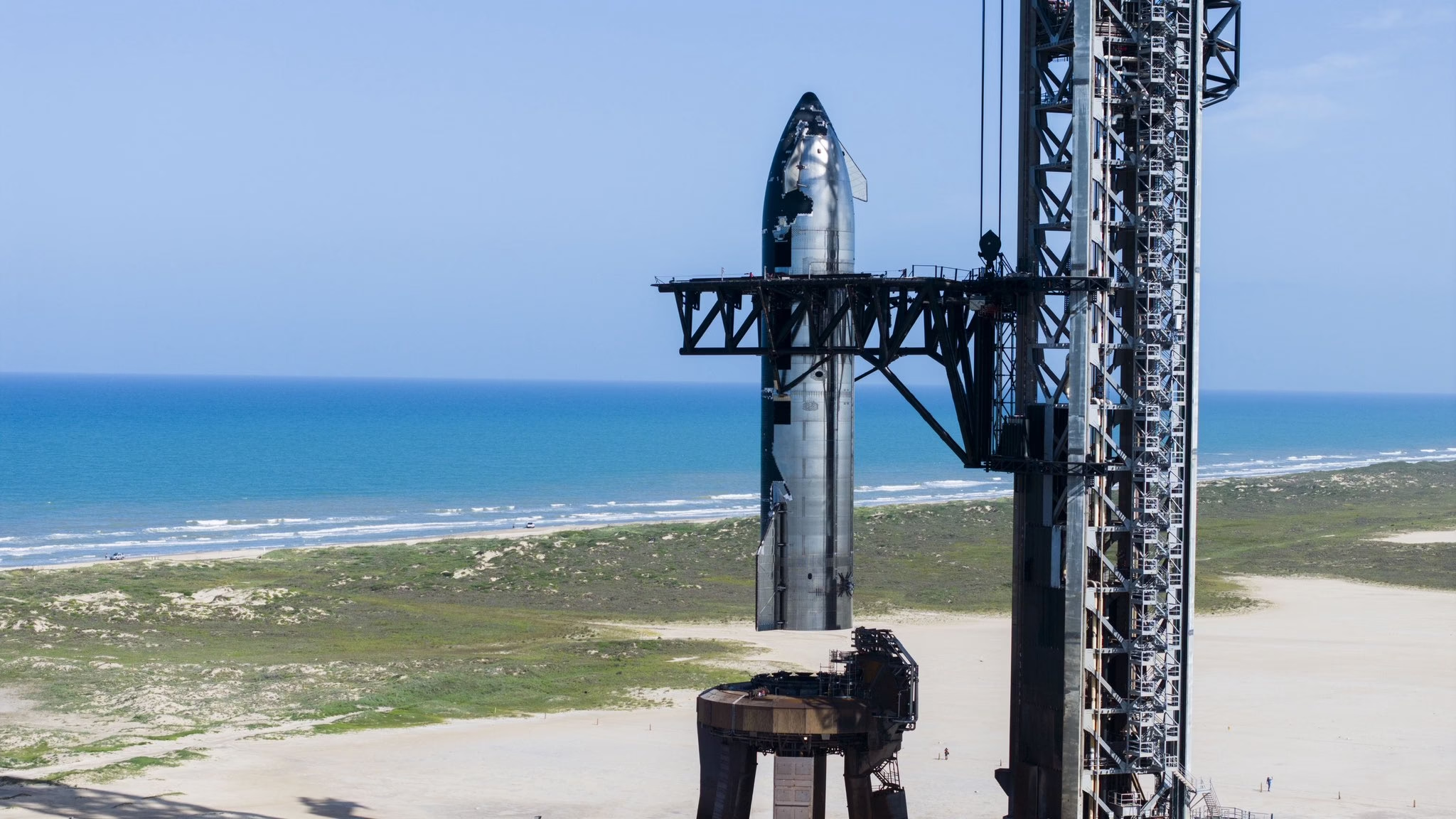SpaceX has rolled its Super Heavy booster to the launch pad at Starbase, Texas, ahead of the Starship tenth flight test. Learn about the rollout, flight objectives, challenges, and its significance for the future of human space exploration.

Super Heavy Booster Rolls to Launch Pad at Starbase Ahead of Starship Tenth Flight Test
SpaceX has once again drawn the world’s attention as its Super Heavy booster was rolled out to the launch pad at Starbase, Boca Chica, Texas, in preparation for the much-anticipated tenth flight test of Starship. This milestone brings the company one step closer to realizing its ambitious goals of building a fully reusable spacecraft capable of transporting humans and cargo to the Moon, Mars, and beyond.
The sight of the towering booster moving toward the pad is not just a routine procedure—it is a moment that captures the imagination of engineers, space enthusiasts, and policymakers across the globe. As SpaceX inches closer to another test flight, excitement and speculation are rising about what the next chapter in the Starship program will deliver.
The Significance of the Rollout: Starship Tenth Flight Test
The movement of the Super Heavy booster to the launch pad marks a critical phase in the pre-flight process. For SpaceX, each rollout is more than logistics—it is a symbolic demonstration of progress and readiness.
The tenth flight test of Starship is not just another number in a sequence. It represents the culmination of lessons learned from previous missions, engineering refinements, and the relentless pursuit of reusability. SpaceX has made it clear that every launch attempt, whether ending in success or failure, is an opportunity to improve the system.
By moving the booster to the pad, SpaceX signals that hardware integration, ground systems, and safety checks are entering their final phases. This step brings the company closer to conducting another flight that will test Starship’s capabilities under real-world conditions.
What Makes the Super Heavy Booster Unique: Starship Tenth Flight Test
The Super Heavy booster is central to the Starship system. Standing nearly 70 meters tall, it is the most powerful rocket booster ever constructed. When paired with the Starship upper stage, the fully stacked vehicle reaches about 120 meters, making it the tallest and most powerful rocket in history.
Key features include:
- 33 Raptor engines that provide over 16 million pounds of thrust.
- A fully reusable design aimed at slashing launch costs.
- Capability to carry over 150 metric tons to low Earth orbit.
- Precision landing mechanisms designed for rapid turnaround between flights.
The scale of this booster is unprecedented, representing a leap forward in rocket engineering. Its rollout is always a visually striking moment, underscoring SpaceX’s bold vision for the future.
Learning from Previous Starship Flights
The upcoming tenth test will build upon the experiences of the first nine flights, which included both spectacular achievements and dramatic setbacks.
- Early Flights: Focused on validating design elements, aerodynamics, and structural endurance.
- High-Altitude Tests: Demonstrated Starship’s ability to perform controlled maneuvers before landing attempts.
- Orbital Attempts: Proved that the system could survive intense conditions during launch, stage separation, and partial re-entry.
- Recent Successes: Starship has managed to complete several mission milestones, such as improved booster performance and progress in heat shield durability.
Each test has provided invaluable data, and the tenth flight is expected to push the program closer to reliable orbital operations.
The Road to the Tenth Flight
Moving the booster to the launch pad is part of a carefully choreographed process that involves multiple stages:
- Booster Assembly: The integration of engines, tanks, and structural components.
- Transportation: A slow and deliberate move to the launch pad using specialized carriers.
- Pad Integration: Connecting the booster to the launch mount and ground systems.
- Static Fire Tests: Firing the engines while the booster is secured, ensuring they perform as expected.
- Stacking: Attaching the Starship upper stage atop the booster to form the full vehicle.
- Final Checks: Safety, fueling, and software readiness tests ahead of launch day.
By rolling the booster out, SpaceX has effectively begun the final countdown to the tenth flight test.
What to Expect from the Tenth Starship Test: Starship Tenth Flight Test
While SpaceX has not disclosed every detail of the flight profile, industry watchers anticipate several key objectives:
- Successful Booster Separation: Refining the process of stage separation at high altitude.
- Starship Re-entry Test: Evaluating the heat shield under intense conditions as the spacecraft re-enters Earth’s atmosphere.
- Controlled Landings: Testing whether the booster can return safely to the Gulf of Mexico or a landing pad.
- Data Collection: Gathering metrics on propulsion, structural endurance, and thermal protection.
The flight is expected to be more ambitious than previous ones, pushing the system closer to operational readiness.
Starship’s Role in Space Exploration: Starship Tenth Flight Test
The Starship system is not designed for one purpose alone—it is envisioned as the backbone of future space exploration.
- NASA’s Artemis Program: Starship has been selected as the lunar lander for Artemis III, which aims to return astronauts to the Moon.
- Mars Colonization: Elon Musk’s long-term vision is to use Starship to establish a sustainable settlement on Mars.
- Satellite Deployment: Its massive payload capacity could revolutionize the launch of satellites and megaconstellations.
- Commercial Travel: Starship may one day enable rapid point-to-point travel on Earth, cutting intercontinental flight times to under an hour.
This versatility makes every step in its development, including the current rollout, a matter of global interest.
Challenges on the Road Ahead: Starship Tenth Flight Test
Despite its promise, the Starship program faces significant challenges.
- Technical Complexity: Developing a fully reusable rocket of this size is unprecedented.
- Regulatory Oversight: Each launch requires clearances from the FAA and environmental authorities.
- Safety: Human spaceflight aspirations demand flawless reliability.
- Infrastructure: Building ground systems that can support such powerful launches is itself a challenge.
- Funding: While SpaceX has strong financial backing, the cost of development is massive.
The rollout of the booster demonstrates progress, but the path forward will demand constant problem-solving and innovation.
The Human Side of Starship
What makes this moment compelling is not just the scale of the technology—it is the story of the people behind it. Engineers, technicians, and visionaries at SpaceX have spent years working on components, testing systems, and refining designs.
For the public, the sight of the booster moving to the pad is more than hardware in motion. It symbolizes human curiosity, resilience, and the desire to push boundaries. Communities near Starbase also play a role, living alongside history in the making and often participating in public outreach and discussions.
Global Reactions to the Rollout
Every time SpaceX prepares for a new test, the global space community pays close attention. Governments, competitors, and enthusiasts analyze the implications.
- NASA and Artemis Partners: Closely watch progress, since Starship’s success directly impacts lunar mission timelines.
- Commercial Satellite Operators: Eager for Starship’s potential to launch large payloads at lower costs.
- International Space Agencies: Observe how the technology might reshape global collaboration and competition.
- Space Enthusiasts: Follow the developments with anticipation, often gathering near Starbase or watching livestreams.
The rollout of the booster ahead of the tenth flight is already sparking conversations worldwide.
A Historic Moment in the Making
As the Super Heavy booster stands poised at the launch pad, anticipation grows for what could be one of the most significant test flights in recent space history. The tenth Starship flight is not expected to be perfect—no experimental test ever is—but it will push the boundaries of what humanity can achieve.
For SpaceX, it is another step toward proving that a fully reusable rocket system is not just a dream, but an attainable reality. For the world, it is a glimpse into a future where space is more accessible, affordable, and transformative.
https://x.com/SpaceX/status/1958611083486536162?t=Tt-4y_hb0FcUUE3hfHs1qQ&s=19
Conclusion: Starship Tenth Flight Test
The rollout of the Super Heavy booster to the launch pad at Starbase is more than a technical milestone—it is a testament to human determination to explore beyond our home planet. With the tenth Starship test flight on the horizon, SpaceX continues to blend ambition with engineering, setbacks with learning, and vision with reality.
From the towering booster now awaiting its turn to roar to life, to the possibility of carrying astronauts to the Moon and eventually Mars, every movement at Starbase signals progress toward a new era of space exploration.
The world now waits for the ignition of engines, the thunder of liftoff, and the lessons that the tenth test will bring. Whether successful or not, it will shape the next chapter in humanity’s journey to the stars.
Starship Set to Launch Again Next Month: Elon Musk’s Bold Next Step in Space Exploration
FAQs: Starship Tenth Flight Test
Q1. What is the Super Heavy booster?
The Super Heavy booster is the first stage of SpaceX’s Starship rocket system. It is the most powerful booster ever built, standing about 70 meters tall and powered by 33 Raptor engines, designed to carry the Starship upper stage into orbit.
Q2. Why was the Super Heavy booster moved to the launch pad?
Moving the booster to the launch pad marks the final stages of preparation for the Starship Tenth Flight Test. At the pad, it undergoes integration, static fire tests, and final checks before liftoff.
Q3. Where is the launch taking place?
The launch will take place at SpaceX’s Starbase facility in Boca Chica, Texas, which serves as the primary test site for Starship development.
Q4. What makes the Starship system unique?
Starship is a fully reusable two-stage rocket system. When combined with Super Heavy, it can carry over 150 metric tons to low Earth orbit, making it the largest and most powerful launch system in history.
Q5. What are the goals of the tenth flight test?
The key objectives include testing stage separation, booster return, Starship re-entry, heat shield durability, and collecting performance data for future missions.
Q6. How tall is Starship when fully stacked?
When stacked on top of the Super Heavy booster, Starship reaches about 120 meters in height, making it taller than NASA’s Saturn V and the Space Launch System.
Q7. What role does Starship play in NASA’s Artemis program?
NASA has selected Starship as the lunar lander for the Artemis III mission, which aims to return astronauts to the Moon later this decade.
Q8. Will the Super Heavy booster land back after launch?
SpaceX aims for controlled landings of the Super Heavy booster in future tests. Depending on test objectives, the booster may attempt to splash down or execute a landing maneuver near the Gulf of Mexico.
Q9. How does the Starship program impact future space exploration?
Starship is designed for missions to the Moon, Mars, and beyond. Its massive payload capacity and reusability could lower launch costs, enabling large-scale space exploration and even commercial applications.
Q10. How can the public watch the test flight?
SpaceX typically livestreams Starship test flights on its official website and YouTube channel, attracting millions of viewers worldwide.

